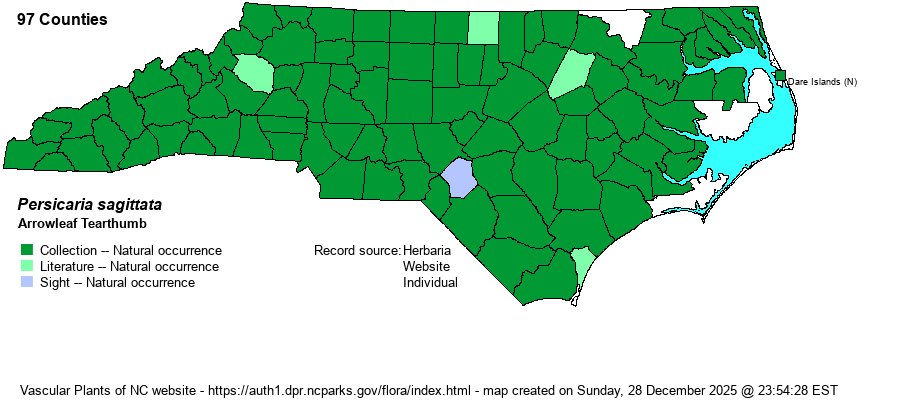| Author | (L.) H. Gross ex Nakai | |
| Distribution | Throughout the state; no doubt found in every county.
Newf. to Man., south to FL and TX. | |
| Abundance | Common statewide, except infrequent to locally frequent in the far eastern counties. Surprisingly, no records yet for well-worked Carteret and Hyde counties. | |
| Habitat | Wet to seasonally wet marshes, beaver pond marshes, impoundment margins, bottomlands and floodplains, montane seepage bogs, roadside ditches, powerlines. |
| Phenology | Flowering and fruiting May-November. | |
| Identification | Arrowleaf Tearthumb is easy to identify by its sprawling stems (up to 6 feet long) and branches that are beset with sharp, stiff, hooked prickles. Stems usually are dull red color. Leaves are narrowly elliptical or lance-shape, with 2 backward pointing lobes. Halberd-leaf Tearthumb (P. arifolia) has much broader leaves with triangular basal lobes that point sideways. Each has small balls of pink to white flowers on long stalks, generally held above the leaves. When walking through a marsh, be alert to its presence, as stands of it can easily tear your flesh and clothing -- a very painful reminder! | |
| Taxonomic Comments | Many references still name it as Polygonum sagittatum.
Many species formerly treated in the genus Polygonum have been moved to Persicaria, the smartweeds. These are generally erect and tall plants with terminal and axillary floral spikes; most occur in wetlands. Others remain in Polygonum, the knotweeds, which are generally prostrate to ascending and with inconspicuous axillary flowers. They occur mostly in dry soils and tend to be weedy.
Attention must be paid to the small collars at the junction of the main stem and leaf stems (called ocreae) and whether they possess terminal hairs or bristles. Some keys also refer to the even smaller collars from which flowers emerge (called ocreolae). Another important ID character is the surface of the greenish sepals -- whether smooth or dotted with indentations (punctate). | |
| Other Common Name(s) | Arrow-vine | |
| State Rank | S5 | |
| Global Rank | G5 | |
| State Status | | |
| US Status | | |
| USACE-agcp | OBL link |
| USACE-emp | OBL link |

